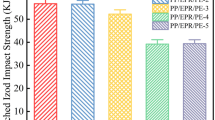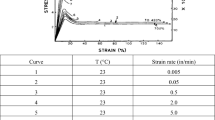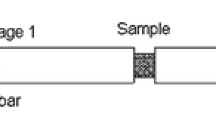Abstract
Herein, the morphological properties of polypropylene/polyolefin elastomer (PP/POE) composites with various rubber compositions are investigated by scanning electron microscopy (SEM). Further, to understand the relationship between the rubber domain size and the impact toughness of the PP composites, the phase structure and rubber particle size in the PP matrix are analyzed. The results indicate that an increased flowability of the rubber reduces the domain size, thereby enhancing the impact strength of the PP composite. In particular, the maximum impact strength of 76 kJ/m2 is obtained for the PP/POE composite in which an increased concentration of ethylene octene random copolymer (EOR) is used as the POE. The experimental results are in good agreement with the interparticle distance model for plastic/rubber blends. The results demonstrate that the rubber particle size in the polymer matrix is an important parameter for designing optimized thermoplastic elastomers.
Similar content being viewed by others
Explore related subjects
Discover the latest articles, news and stories from top researchers in related subjects.Avoid common mistakes on your manuscript.
Introduction
Thermoplastic elastomers (TPEs) are promising materials for a variety of applications, including automotive parts, footwear, roofing materials, and medical products, due to their outstanding thermal properties, chemical resistance, and easy processability [1,2,3,4]. In particular, the TPE used as a vehicle airbag cover requires excellent toughness and needs to be deployed with proper tearing, i.e., without scattering the pieces and breaking in case of direct collision. Consequently, since the initial commercialization of thermoplastic polyurethanes in the 1950s, the improvement of TPE toughness has been vigorously studied by mixing with soft elastomers such as styrene block copolymer, vulcanized polymer, and polyolefin elastomer (POE) [5,6,7,8]. Among the various impact modifiers, ethylene butene random copolymer (EBR) and ethylene octene random copolymer (EOR) have been widely accepted for TPE airbag cover application, with the benefit of good impact stiffness balance.
In the present study, EOR or EBR are added to the polypropylene (PP) matrix to examine the effect of rubber particle size upon the toughness of the PP composite. The TPE is prepared by melt-mixing, thereby resulting in two different phases while retaining the properties of both the thermoplastic and the elastomer [9]. In the 1980s, Wu demonstrated the relationship between phase structure and impact toughness using nylon/rubber blends [10]. Therefore, PP/POE composites are prepared herein with various rubber compositions in order to determine the optimum PP composite for improved impact strength. In addition, the morphologies of the PP/POE composites are observed via scanning electron microscopy (SEM), and impact strength tests are employed. The present work is mainly focused on the effect of the rubber flowability upon the phase formation in the PP matrix, with the aim of improving the toughness of the PP composite.
Materials and methods
Materials
Due to its excellent elastic behavior, a POE was used as an impact modifier for improving the mechanical properties of the TPE. Further, to investigate the influence of POE type and flowability upon the properties of the PP/POE composites, a high-crystallinity impact PP (HCPP) with a melt index (MI) of 10 g/10 min was used as the base polymer, where the MI is a measure of the ease of flow of the polymer. Six types of POEs were used, including two types of EBR (labelled EBR1 and EBR2 in Table 1) and four types of EOR (labelled EOR1–4 in Table 1), with MI values of 0.5 or 5.0 g/10 min (measured at 2.16 kg and 190 ℃ according to ASTM D1238). All POEs were obtained from Dow Chemicals (Korea). In particular, EOR 3 and 4 exhibit low glass transition temperatures due to a special copolymerization process.
Sample preparation
Samples of the raw materials with diameters of 40 mm were prepared by compounding in a co-rotating twin extruder (HS40, Changsung). The extruded TPE pellets were then molded with a 220-ton injection machine (WIZ220E, LS Mtron).
Characterization
PP and POE morphology was analyzed by Nova Nano630 SEM with Everhart–Thornley Detector (ETD) at an accelerating voltage of 5 kV. Size analysis of rubber domain in PP/POE composites was performed using Image J software. Izod impact strength was obtained by using a low-temperature impact tester (In-Chamber type; No 258-L, Yasuda).
Results and discussion
Phase morphology
In order to understand influence of the rubber contents and thermal properties upon the mechanical properties, various PP/EOR composites with rubber contents of 20 wt.% (designated PP/EORX-20, where X = 1 or 2) or 40 wt.% (designated PP/EORX-40, where X = 1, 2, 3, or 4) were prepared, where the PP/EOR3 and PP/EOR4 types have correspondingly lower glass transition temperatures (Tg). In each case, the PP had an MI of 10 g/10 min (measured at 2.16 kg and 230 ℃ based on ASTM D1238), and the POE had an MI of either 0.5 or 5.0 (measured at 2.16 kg and 190 ℃ based on ASTM D1238), as summarized in Table 2. In addition, composites containing 20 wt.% EBR with MI values of 0.5 (PP/EBR1-20) and 5.0 (PP/EBR1-20) were prepared.
As the mechanical properties of the TPE depend on the phase structure of the composite [10], the phase morphologies of the PP/EOR and PP/EBR composites made with rubber contents of 20 and 40 wt.% are presented in Figs. 1 and 2. As shown in Fig. 1, the POE domains (dark phase) are dispersed in the PP matrix (light phase), identical red circles are put in Figs. 1 and 2 to compare the size of rubber domains. In Fig. 1, samples a and c with an MI of 5.0 are compared with samples b and d with an MI of 0.5, it was found that the higher the flowability of POE, the smaller the rubber domain size. This trend is consistent with the results for the other PP/EOR composites in Fig. 2. In addition, the size of rubber domains according to POE types was compared. The types of POE used in Fig. 1 were a and b for EOR, and c and d for EBR. When the MI is the same, the size of the rubber domain is not significantly affected by the type of POE. Figure 2 compares the size of rubber domains according to the ratio of POE. The proportion of EOR in the composite is 40 wt% for a and b and 20 wt% for c and d. The size of the rubber domain increased as the POE content increased, which was confirmed regardless of flowability. These results are attributed to the flowability of the rubber in the PP matrix under the melt state. In theory, the size of the dispersed phase depends on the rheological and interfacial properties during melt blending, while the dispersed phase is smaller when the viscosity ratio is close to unity in the PP/POE composites [11,12,13,14]. Therefore, the POEs with MI values of 0.5 (such as EOR1, EBR1, and EOR3) have low mobility in the PP matrix, which results in more coarsening and a larger size of the rubber phase than those observed in the rubbers with MI values of 5.0 (EOR2, EBR2, and EOR4). This effect is shown schematically in Fig. 3. In Fig. 3, there are chemical structures of EOR and EBR. Since there is no difference in the rubber domain according to the type of POE, it was confirmed that there is no effect depending on the carbon length of the monomer. Also, in the case of PP/POE composites with high flowability, the size of rubber domains is small, and in the case of low flowability, the size of rubber domains increases.
Impact strength
The effects of domain size upon the mechanical properties of the PP/POE composites are further revealed by the analytical results in Fig. 4. Here, the rubber domain size in the PP matrix is seen to increase with decreasing MI of the rubber, and with decreasing EOR content, due to the flowability of the rubber. However, although a difference in flowability was expected due to the difference in side-chain length [15], no effect on the domain size is observed due to the difference between the EOR and EBR. This is probably due to the low dispersion of the EBR in the PP matrix, which will be further described in the following paragraphs.
The toughnesses of the various as-prepared PP/POE composites are indicated by the impact strength results obtained under different temperature conditions (23 and –30 ℃) in Fig. 5. In detail, the toughness of a polymer/rubber composite is determined by the interparticle distance between adjacent rubber particles [10, 16]. In accordance with the interparticle distance model, the critical rubber volume fraction (φc) is given by the following equation:
where dr is the rubber particle diameter, and τc is the critical interparticle distance, which is proportional to the brittle fracture strength of the matrix polymer [17]. According to the work of Wu, the impact strength should improve with decreasing rubber domain size and with increasing critical distance [10]. The impact strength of PP/POE increases as the tough brittle transition of the composite occurs and is related to the ratio (L/d) of center-to-center particle separation (Lc) and diameter (d) of the rubber domain. Currently, the maximum L/d at which the tough brittle transition of the composite occurs is called the critical ratio, and is given by the following equation:
The L value is the sum of the interparticle distance T and the rubber domain diameter d and is converted to L/d = T/d + 1 accordingly and can be obtained through Eq. (1). As φc increases, (L/d)c tends to decrease, reaching an interparticle distance that corresponds to the critical interparticle distance of the composite when d is of a similar size. This causes a tough-to-brittle transition of the composite and increases the impact strength of the PP/POE composite. PP/POE composites made by increasing the volume of POE or mixing POE with high MI increase φc and increase impact strength. Indeed, the results in Figs. 4 and 5 demonstrate that the impact strengths of the PP/EOR composites depend on the rubber domain size at temperature of 23 ℃. Moreover, the composites containing 40 wt.% EOR exhibit greater impact strengths than those containing 20 wt.% EOR, whereas the effects of glass transition temperature and the type of rubber are insignificant. In addition, the impact strength at -30 ℃ of the composite containing 40 wt% of EOR remarkably increased, confirming that the impact strength at low temperature is affected by the change in τc and dr due to the increase in the volume fraction in the φc equation. As mentioned above, the low dispersion of the rubber in the polymer matrix of the PP/EBR1-20 needs to be overcome in order to achieve better toughness [18]. Notably, both the PP/EOR1-40 and PP/EOR2-40 composites show excellent impact strengths of 40.3 and 76.0 kJ/m2, respectively, under the low temperature condition. The observed increase in impact strength occurs because the polymer chains become increasingly entangled as the EOR content increases [19,20,21]. In other words, the smaller the rubber size, and the more overlap between the rubber particles in the PP matrix, the better will be the toughness of the composite.
Conclusions
Herein, polypropylene/polyolefin elastomer (PP/POE) composites with various rubber compositions were prepared in order to investigate the effects of the rubber particle size upon the toughness, with the aim of designing a thermoplastic elastomer (TPE) composite with enhanced impact strength. Morphological analysis showed that the PP composites containing rubber with a higher melt index (MI) have a smaller domain size, thereby resulting in improved impact strength. Among the POEs used for the PP composites, ethylene octene random copolymer (EOR) exhibited better dispersion than ethylene butene random copolymer (EBR), while the PP/EOR1-40 composite (i.e., that containing 40 wt.% EOR and having an MI of 0.5) had the highest impact strength of 56.5 and 76.0 kJ/m2 at temperatures of 23 and –30 ℃, respectively. These results suggest that the toughness of the PP/POE composite is improved by increased overlap between the rubber particles due to the increased entanglement among the molecular chains. The results of this study are expected to provide new insights for the preparation of optimized TPEs.
References
Holden NRLG, Bishop ET (1969) Thermoplastic elastomers. J Polym Sci Part C Polym Symp 26:37–57. https://doi.org/10.1002/polc.5070260104
Spontak RJ, Patel NP (2000) Thermoplastic elastomers: Fundamentals and applications. Curr Opin Colloid Interface Sci 5:334–341. https://doi.org/10.1016/s1359-0294(00)00070-4
Ismail H (2002) Suryadiansyah, Thermoplastic elastomers based on polypropylene/natural rubber and polypropylene/recycle rubber blends. Polym Test 21:389–395. https://doi.org/10.1016/S0142-9418(01)00101-5
Amin S, Amin M (2011) Thermoplastic elastomeric (TPE) materials and their use in outdoor electrical insulation. Rev Adv Mater Sci 29:15–30
Abreu FOMS, Forte MMC, Liberman SA (2005) SBS and SEBS block copolymers as impact modifiers for polypropylene compounds. J Appl Polym Sci 95:254–263. https://doi.org/10.1002/app.21263
Abdou-Sabet S, Puydak RC, Rader CP (1996) Dynamically vulcanized thermoplastic elastomers. Rubber Chem Technol 69:476–494
Prut EV, Erina NA, Karger-Kocsis J, Medintseva TI (2008) Effects of blend composition and dynamic vulcanization on the morphology and dynamic viscoelastic properties of PP/EPDM blends. J Appl Polym Sci 109:1212–1220. https://doi.org/10.1002/app.28158
Kresge EN (1991) Polyolefin thermoplastic elastomer blends. Rubber Chem Technol 64:469–480
Naderi G, Lafleur PG, Dubois C (2008) The influence of matrix viscosity and composition on the morphology, rheology, and mechanical properties of thermoplastic elastomer nanocomposites based on EPDM/PP. Polym Compos 29:1301–1309. https://doi.org/10.1002/pc.20495
Wu S (1985) Phase structure and adhesion in polymer blends: A criterion for rubber toughening. Polymer (Guildf) 26:1855–1863. https://doi.org/10.1016/0032-3861(85)90015-1
Wu S (1987) Formation of dispersed phase in incompatible polymer blends: Interfacial and rheological effects. Polym Eng Sci 27:335–343. https://doi.org/10.1002/pen.760270506
Kim BK, Do IH (1996) Effect of viscosity ratio, rubber composition, and peroxide/coagent treatment in PP/EPR blends. J Appl Polym Sci 61:439–447. https://doi.org/10.1002/(SICI)1097-4628(19960718)61:3%3c439::AID-APP6%3e3.0.CO;2-J
Chung O, Coran AY (1997) The morphology of rubber/plastic blends. Rubber Chem Technol 70:781–797
Zhang X, Maira B, Hashimoto Y, Wada T, Chammingkwan P, Thakur A, Taniike T (2019) Selective localization of aluminum oxide at interface and its effect on thermal conductivity in polypropylene/polyolefin elastomer blends. Compos B Eng 162:662–670. https://doi.org/10.1016/j.compositesb.2019.01.043
Ohtaki H, Deplace F, Vo GD, Lapointe AM, Shimizu F, Sugano T, Kramer EJ, Fredrickson GH, Coates GW (2015) Allyl-terminated polypropylene macromonomers: A route to polyolefin elastomers with excellent elastic behavior. Macromolecules 48:7489–7494. https://doi.org/10.1021/acs.macromol.5b01975
l’Abee RMA, van Duin M, Spoelstra AB, Goossens JGP, (2010) The rubber particle size to control the properties-processing balance of thermoplastic cross-linked elastomer blends. Soft Matter 6:1758–1768
Li F, Gao Y, Yan N, Zhang C, Zhang X, Jiang W (2022) Effect of polypropylene molecular weight distribution on the balance between the toughness and rigidity of the impact polypropylene composites. J Appl Polym Sci 139. https://doi.org/10.1002/app.51834
Ahn S, Park C, Park S, Choi J, Seok Y, Yoo Y (2022) Effective flow modifiers for high-filled poly (phenylene sulfide) composites based on chemical structure similarity. Compos Sci Technol 230:109721
Liu G, Qiu G (2013) Study on the mechanical and morphological properties of toughened polypropylene blends for automobile bumpers. Polym Bull 70:849–857. https://doi.org/10.1007/s00289-012-0880-1
Lendvai L (2020) A novel preparation method of polypropylene/natural rubber blends with improved toughness. Polym Int 70:298–307. https://doi.org/10.1002/pi.6133
Liu S, Wang K, Zhang Z, Ren Y, Chen L, Sun X, Liang W (2020) Effects of ethylene-octene copolymer (POE) on the brittle to ductile transition of high-density polyethylene/POE blends. Polym Eng Sci 60:2640–2652. https://doi.org/10.1002/pen.25532
Acknowledgements
This work was supported by the Materials/Parts Technology Development Program (20019205) funded by the Ministry of Trade, Industry & Energy (MOTIE, Korea) and the R&D projects tailored to local demand funded by the Jeonnam Technopark in 2023.
Author information
Authors and Affiliations
Corresponding author
Ethics declarations
Competing interes
The authors declare that they have no known competing financial interests or personal relationships that could have appeared to influence the work reported in this paper.
Additional information
Publisher's Note
Springer Nature remains neutral with regard to jurisdictional claims in published maps and institutional affiliations.
Rights and permissions
Springer Nature or its licensor (e.g. a society or other partner) holds exclusive rights to this article under a publishing agreement with the author(s) or other rightsholder(s); author self-archiving of the accepted manuscript version of this article is solely governed by the terms of such publishing agreement and applicable law.
About this article
Cite this article
Han, I.S., Park, C., Jeon, H. et al. Polypropylene/polyolefin elastomer composites with enhanced impact strength: the effect of rubber domain size on toughness. J Polym Res 30, 224 (2023). https://doi.org/10.1007/s10965-023-03615-8
Received:
Accepted:
Published:
DOI: https://doi.org/10.1007/s10965-023-03615-8









